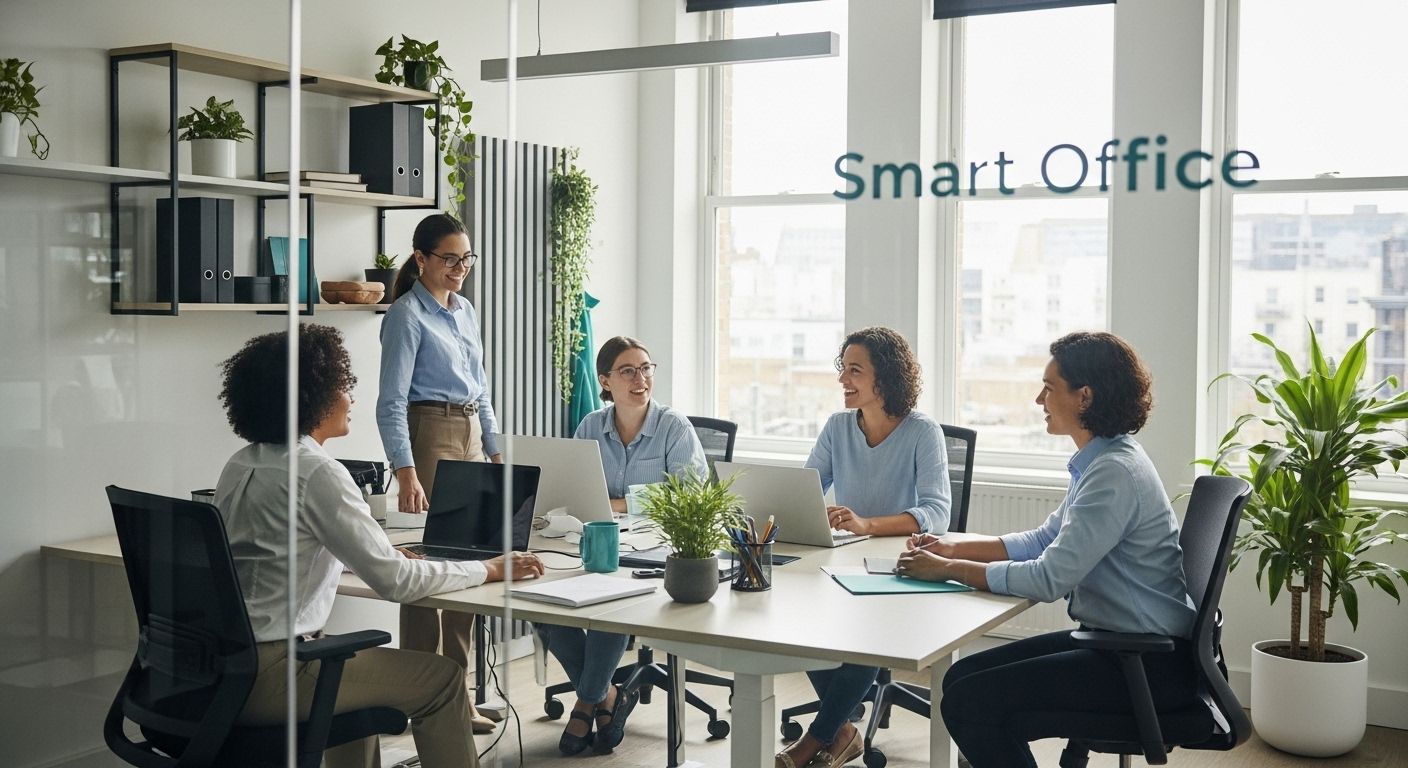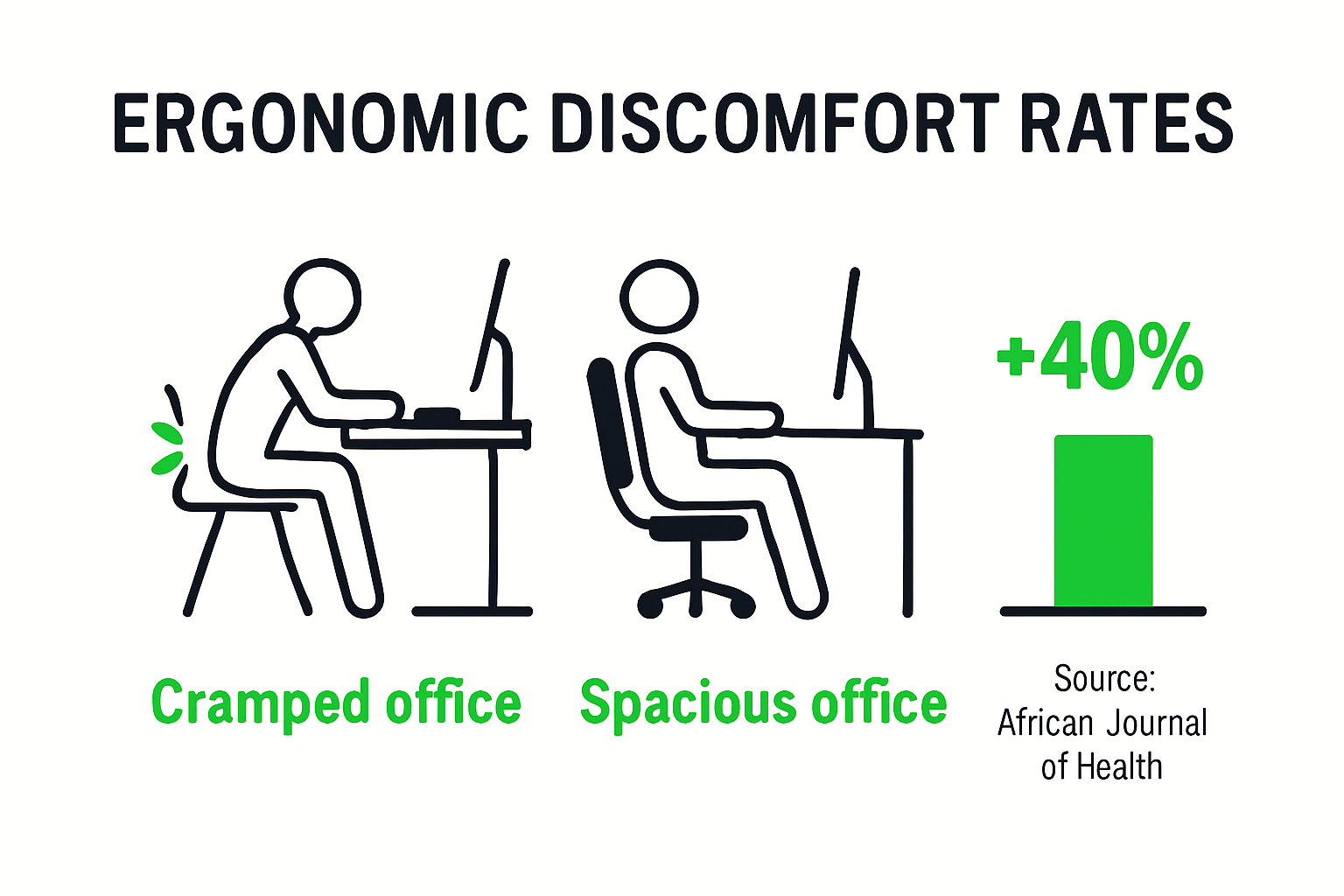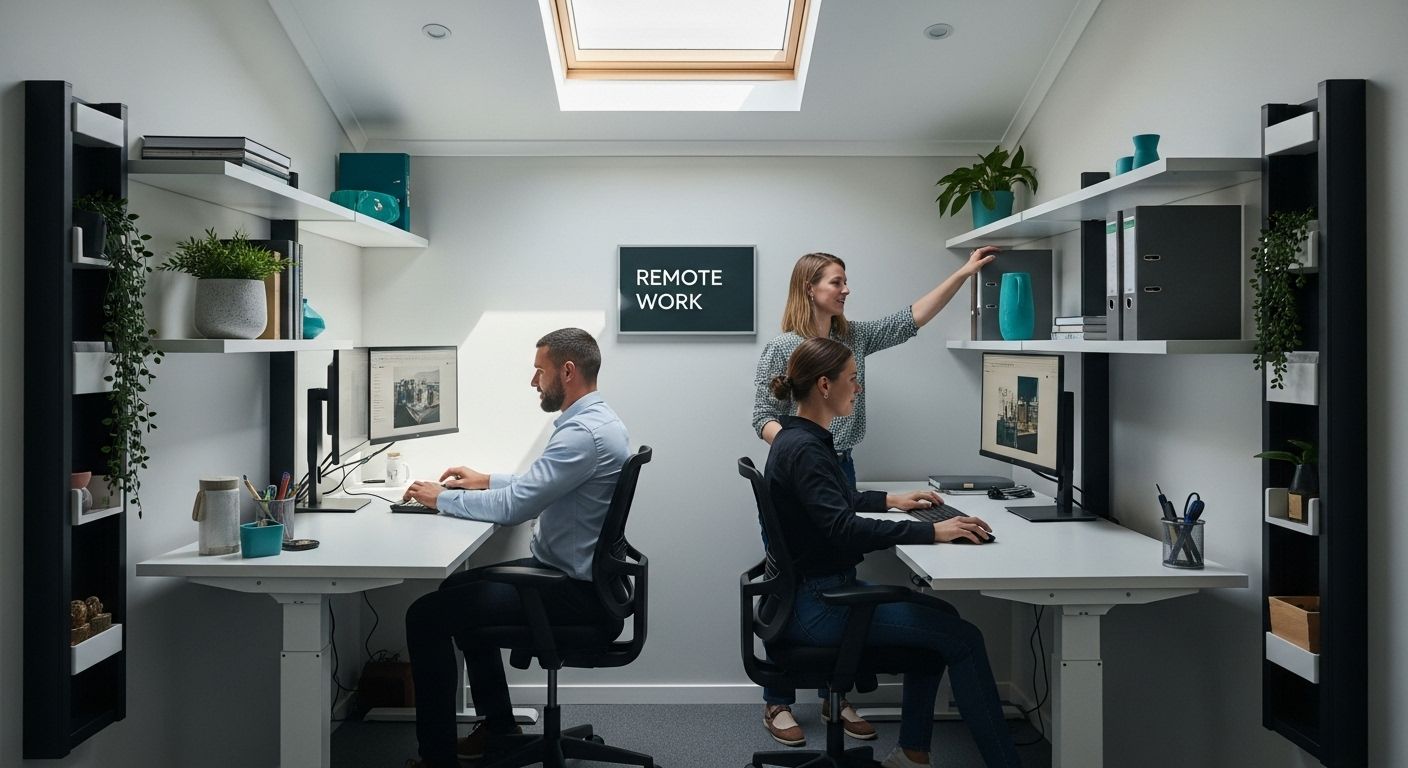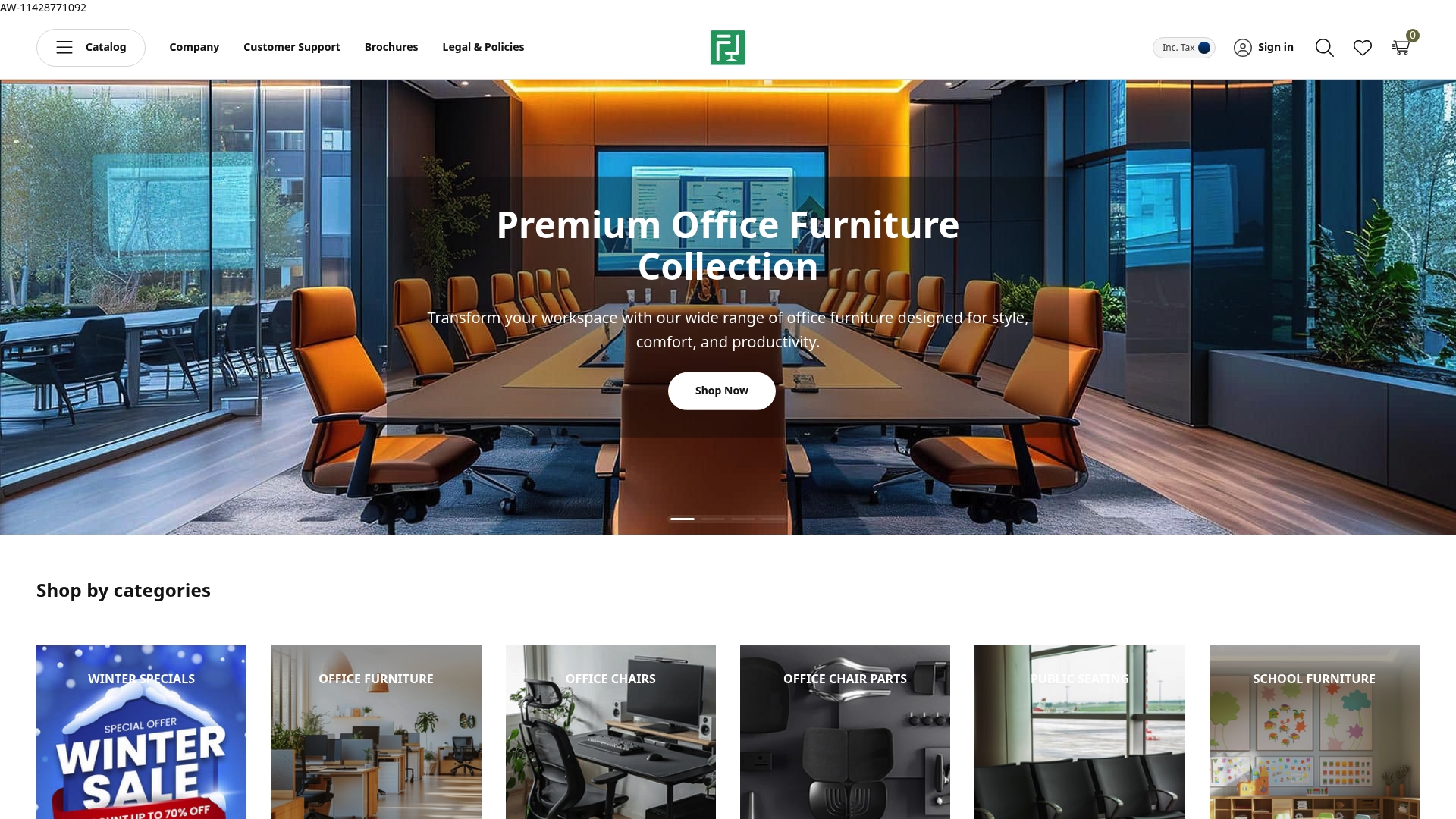Smart Office Design for Small Spaces in Southern Africa
Aug 10, 2025
Smart Office Design for Small Spaces in Southern Africa

Small offices in Southern Africa are under more pressure than ever to deliver big results in tiny spaces. Urban rents in cities like Joburg and Cape Town have shot up by about 15 percent a year, squeezing businesses and forcing some creative thinking. Believe it or not, cramming more desks into less room is not what’s making companies thrive. The real secret lies in flexible furniture and smart tech that turn every square metre into a powerhouse for productivity.
Table of Contents
- Understanding Space Challenges In Offices
- Creative Solutions For Small Office Design
- Essential Furniture And Storage Ideas
- Local Inspiration: Case Studies From Southern Africa
Quick Summary
| Takeaway | Explanation |
|---|---|
| Maximize every square metre of workspace | Rising real estate costs make efficient spatial planning essential for businesses in urban areas. |
| Adopt modular and adaptive furniture systems | Flexible furniture allows quick reconfiguration of spaces, enhancing responsiveness to changing work needs. |
| Leverage technology for spatial optimization | IoT systems and cloud computing can improve workspace efficiency by tracking usage and reducing physical infrastructure requirements. |
| Utilize vertical space for storage | Wall-mounted and vertical storage solutions free up floor area, maximizing usability in small offices. |
| Prioritize ergonomic, compact workstations | Slim, versatile workstations can support employee health and productivity while fitting into limited spaces. |
Understanding Space Challenges in Offices
Modern workspaces in Southern Africa face increasingly complex spatial constraints that demand innovative and strategic office design solutions. As businesses evolve and urban real estate becomes more expensive, understanding the nuanced challenges of creating functional work environments in limited spaces has become critical for organisational success.
The Economic Pressure of Small Office Spaces
In major urban centres across Southern Africa, commercial real estate prices continue to rise dramatically. Research from the South African Property Owners Association indicates that office rental costs in cities like Johannesburg and Cape Town have increased by approximately 15% annually over the past three years. This economic pressure compels businesses to maximise every square metre of available workspace, transforming office design for small spaces from a mere aesthetic consideration into a strategic business imperative.
Companies are increasingly recognising that intelligent spatial planning is not just about fitting furniture into a room but about creating dynamic, adaptable environments that support employee productivity and well-being. The traditional model of fixed workstations and rigid office layouts is rapidly becoming obsolete, replaced by flexible, multifunctional design strategies that can accommodate changing workforce needs.
Ergonomic Challenges in Compact Workspaces
Limiting physical workspace introduces significant ergonomic challenges. A study published in the African Journal of Health revealed that employees working in cramped office environments experience 40% higher rates of musculoskeletal discomfort compared to those in more spacious settings. This underscores the critical importance of thoughtful office design for small spaces that prioritises employee health and comfort.

Effective spatial management requires a holistic approach that considers multiple factors: furniture selection, layout optimization, vertical space utilization, and intelligent storage solutions. Ergonomic chairs with compact footprints, modular desking systems, and multifunctional furniture pieces become essential tools in creating workspaces that feel spacious and comfortable despite limited square meterage.
Technology and Space Efficiency
Technological advancements are playing a transformative role in addressing spatial challenges. Cloud computing, wireless networking, and compact digital devices enable businesses to reduce physical infrastructure requirements while maintaining high levels of connectivity and productivity. Mobile workstations, hot-desking configurations, and collaborative digital platforms allow companies to create more fluid, adaptable work environments that are not constrained by traditional spatial limitations.
The future of office design in Southern Africa will increasingly depend on creative problem-solving, where spatial efficiency meets technological innovation. Businesses that can successfully integrate smart design principles with cutting-edge technological solutions will be best positioned to thrive in increasingly competitive and space-constrained urban landscapes.
As companies continue to navigate these complex spatial challenges, the key lies in viewing office design not as a static constraint but as a dynamic, evolving strategy that directly impacts organisational performance and employee satisfaction.
Creative Solutions for Small Office Design
Navigating the challenges of limited office space requires innovative and strategic design approaches that transform constraints into opportunities for enhanced productivity and workplace efficiency. Creative solutions for small office design go beyond mere spatial optimization, encompassing a holistic approach that integrates technology, flexible furniture, and intelligent spatial planning.
Modular and Adaptive Furniture Systems
Research from the Adaptive Architectural Layout study highlights the critical importance of flexible workspace solutions. Modular furniture systems have emerged as a revolutionary approach to maximizing small office environments. These adaptable pieces allow businesses to reconfigure workspaces quickly, supporting different work modes and team configurations.
Multifunctional furniture pieces are particularly effective in small offices. Desks that convert into meeting tables, stackable chairs, and wall-mounted workstations enable businesses to create dynamic environments that can transform within minutes. Our guide on compact workspace solutions provides additional insights into selecting versatile furniture that maximizes limited square meterage.
Technology-Driven Spatial Optimization
A groundbreaking study on smart space design demonstrates how Internet of Things (IoT) technologies can revolutionize small office environments. Smart sensors and integrated technologies enable businesses to understand and optimize space utilization in real-time. These systems can track occupancy, monitor workspace usage, and provide data-driven insights for more efficient office layouts.
Cloud computing and wireless technologies further support spatial efficiency by reducing physical infrastructure requirements. Compact digital devices, wireless charging stations, and minimalist technology solutions allow businesses to create streamlined workspaces that feel open and uncluttered despite limited dimensions.
Vertical Space and Innovative Storage Solutions
Vertical space represents an often-underutilized dimension in small office design. Wall-mounted shelving, floating desks, and floor-to-ceiling storage systems can dramatically increase usable workspace without consuming valuable floor area. Custom-built vertical storage solutions that integrate seamlessly with office aesthetics can transform spatial limitations into design opportunities.
Integrated storage solutions that serve multiple functions are particularly effective. Furniture pieces with built-in storage, such as ottomans with internal compartments or desks with integrated filing systems, help maintain a clean, organized environment while maximizing available space.
The future of small office design in Southern Africa lies in embracing flexibility, technological integration, and creative spatial thinking. By viewing spatial constraints as opportunities for innovation, businesses can create workspaces that are not just functional but inspirational—environments that support collaboration, productivity, and employee well-being despite physical limitations.
Essential Furniture and Storage Ideas
In the realm of small office design, selecting the right furniture and storage solutions becomes a critical strategic decision that directly impacts workspace functionality, employee productivity, and overall organizational efficiency. Research from the International Journal of Environmental Research and Public Health emphasizes that thoughtful furniture selection is not merely about aesthetics but about creating adaptive, ergonomic environments that support diverse work requirements.
Ergonomic Compact Workstations
Compact workstations represent the cornerstone of effective small office design. Modern solutions prioritize slim profiles without compromising functionality. Adjustable height desks, our space-saving desk solutions provide versatile options that can transform between sitting and standing configurations, maximizing limited square meterage while supporting employee health.
Ergonomic chairs with minimal footprints are equally crucial. Designs featuring slim frames, retractable armrests, and efficient lumbar support enable businesses to create comfortable workspaces without consuming excessive floor space. Chairs with wheels and lightweight construction allow for easy reconfiguration, supporting dynamic and flexible work environments.
Intelligent Storage Systems
Vertical storage solutions represent a game-changing approach to spatial management in small offices. Wall-mounted shelving units, floating cabinets, and floor-to-ceiling storage systems dramatically increase storage capacity without sacrificing valuable floor space. Modular storage systems that can be reconfigured based on changing organizational needs provide exceptional flexibility.
Multifunctional furniture with integrated storage capabilities offers another innovative solution. Ottomans with internal compartments, desks with built-in filing drawers, and conference tables with hidden storage compartments enable businesses to maintain clean, uncluttered workspaces while ensuring essential materials remain easily accessible.
Technology-Integrated Furniture Solutions
Contemporary furniture design increasingly incorporates technological integration, further optimizing small office spaces. Desks with built-in charging stations, wireless connectivity options, and cable management systems help reduce visual clutter while supporting modern digital work requirements. Compact docking stations and minimalist tech accessories allow employees to create efficient workstations within limited areas.
Collaborative furniture pieces that support both individual and team-based work are becoming essential. Nested seating arrangements, modular meeting tables, and adaptable workbenches enable businesses to quickly transform spaces to accommodate different work modes and team sizes.
Successful small office design in Southern Africa demands a holistic approach that views furniture and storage not as static elements but as dynamic tools for enhancing workplace productivity. By selecting intelligent, adaptable solutions that prioritize efficiency, comfort, and technological integration, businesses can create inspiring work environments that transcend spatial limitations.
The following table provides a concise overview of essential furniture and storage solutions discussed in the article, along with their main advantages for small offices:
| Solution Type | Example Features | Main Benefits |
|---|---|---|
| Ergonomic Compact Workstations | Adjustable height desks, slim ergonomic chairs | Saves space, supports health, easy reconfiguration |
| Intelligent Storage Systems | Wall-mounted shelves, multifunctional furniture | Maximises storage, keeps workspace uncluttered |
| Technology-Integrated Furniture | Built-in charging, cable management, modular tables | Reduces clutter, supports digital work, flexibility |
Local Inspiration: Case Studies from Southern Africa
Southern Africa’s dynamic business landscape has emerged as a pioneering region for innovative small office design solutions, demonstrating remarkable creativity in transforming spatial constraints into opportunities for remarkable workplace transformation. Research from Sustainable and Smart Spatial Planning in Africa highlights the region’s unique approach to adaptive workspace design.
Cape Town’s Technology StartUp Ecosystem
In the heart of Cape Town’s vibrant technology district, several innovative startups have revolutionized small office design by embracing radical spatial efficiency. One notable example is a fintech company occupying a compact 80 square metre workspace in the city’s central business district. By implementing hot-desking strategies, modular furniture systems, and cloud-based collaboration tools, they created a workspace that accommodates 25 employees without feeling cramped.
Key design strategies included ceiling-mounted storage solutions, foldable workstations, and multi-purpose meeting areas that can transform within minutes. These approaches not only maximized physical space but also promoted a culture of flexibility and dynamic collaboration.
Johannesburg’s Corporate Reimagination
In Johannesburg’s competitive corporate landscape, several medium-sized companies have pioneered innovative approaches to small office design. A notable telecommunications consultancy transformed a traditional 120 square metre office into a highly adaptive workspace by introducing activity-based working principles. By eliminating fixed workstations and creating multiple micro-environments—including quiet zones, collaborative spaces, and informal meeting areas—they dramatically improved employee productivity and satisfaction.
The design incorporated elements like acoustic pods for focused work, movable partition walls, and technology-integrated furniture that supports seamless transitions between individual and group work modes. This approach demonstrated that spatial limitations can be transformed into opportunities for enhanced workplace experience.
Namibian Remote Work Solutions
In Namibia’s emerging business ecosystem, small businesses and entrepreneurial ventures have developed unique strategies for creating efficient workspaces. A digital marketing agency in Windhoek implemented a hybrid design model that combines physical and virtual workspace solutions. By utilizing vertical space, investing in compact ergonomic furniture, and developing robust remote work protocols, they created a workspace that feels expansive despite its limited physical footprint.
Their design incorporated height-adjustable desks, wall-mounted storage systems, and intelligent technology infrastructure that supports seamless collaboration between in-office and remote team members. This approach reflects the growing trend of viewing office design as a flexible, technology-enabled ecosystem rather than a fixed physical environment.

These case studies from Southern Africa illustrate a profound truth: spatial constraints are not limitations but opportunities for innovation. By embracing creative design principles, leveraging technology, and prioritizing human-centric workspace solutions, businesses can transform small offices into dynamic, inspiring environments that drive productivity, collaboration, and employee well-being.
The region’s approach to small office design goes beyond mere spatial optimization—it represents a holistic reimagination of work itself, where physical space becomes a strategic tool for organizational success.
To help clarify the unique strategies used by companies across Southern Africa, the following table summarises the main case studies and their standout design features:
| Location/Case Study | Strategies Used | Key Features |
|---|---|---|
| Cape Town Tech Startup | Hot-desking, modular furniture, cloud tools | Ceiling storage, foldable workstations, multi-purpose meeting spaces |
| Johannesburg Corporate Consultancy | Activity-based working, no fixed desks | Acoustic pods, movable walls, tech-integrated furniture |
| Namibian Digital Agency | Hybrid (physical + virtual) workspace, vertical storage | Height-adjustable desks, wall-mounted storage, remote tech integration |
Frequently Asked Questions
What are the benefits of using modular furniture in small office spaces?
Modular furniture allows for quick reconfiguration of layouts, making it easier to adapt the workspace to changing needs. This flexibility maximizes the use of limited space and ensures that the office can accommodate different work modes and team sizes.
How can technology improve the efficiency of small office layouts?
Technology such as IoT sensors can provide real-time data on space utilization, helping businesses optimize their layouts. Additionally, cloud computing and compact digital devices reduce the need for physical infrastructure, creating a streamlined and efficient workspace.
What are some ergonomic considerations for small office designs?
When designing small offices, it’s essential to choose ergonomic furniture with compact footprints, such as adjustable height desks and supportive chairs. These elements can enhance employee comfort and productivity while ensuring the workspace remains functional.
How can vertical space be utilized effectively in a small office?
Vertical space can be maximized through wall-mounted shelving, storage solutions, and floating desks. These elements free up floor space, allowing for a more open and usable environment while providing ample storage options without consuming valuable square meters.
Transform Your Small Office into a Space of Possibility
Does your workspace feel cramped or cluttered? If your team is struggling with a lack of space, rising rental costs and the challenge of creating a productive environment, you are not alone. The article on smart office design highlights the pressure South African businesses face to maximise every square metre. The demand for ergonomic, flexible furniture and intelligent storage has never been higher, especially when productivity and employee well-being are at stake.

Office Stock understands these unique pain points. Our experienced team supports you with premium solutions specifically crafted for compact workplaces. Unlock more room with space-saving ergonomic chairs and modular desks. Discover innovative storage systems designed to keep your office organised, comfortable and future-ready. Visit Office Stock today and take control of your workspace. Your new office starts with one smart step.
Recommended
- Hexagonal Boardroom Table | Buy Office Furniture Online - Office Stock
- Leather In Room Directory Folder | Buy Uncategorized Online - Office Stock
- Laminating Pouches (A4 - Gloss - 220x310mm - 160 (80+80) Microns - Box 100) | Buy Laminator Consumables Online - Office Stock
- Pastel Turquoise Hob Splashback (598 X 650 X 6mm) | Buy Kitchen Glass Hob Splashbacks Online - Office Stock
